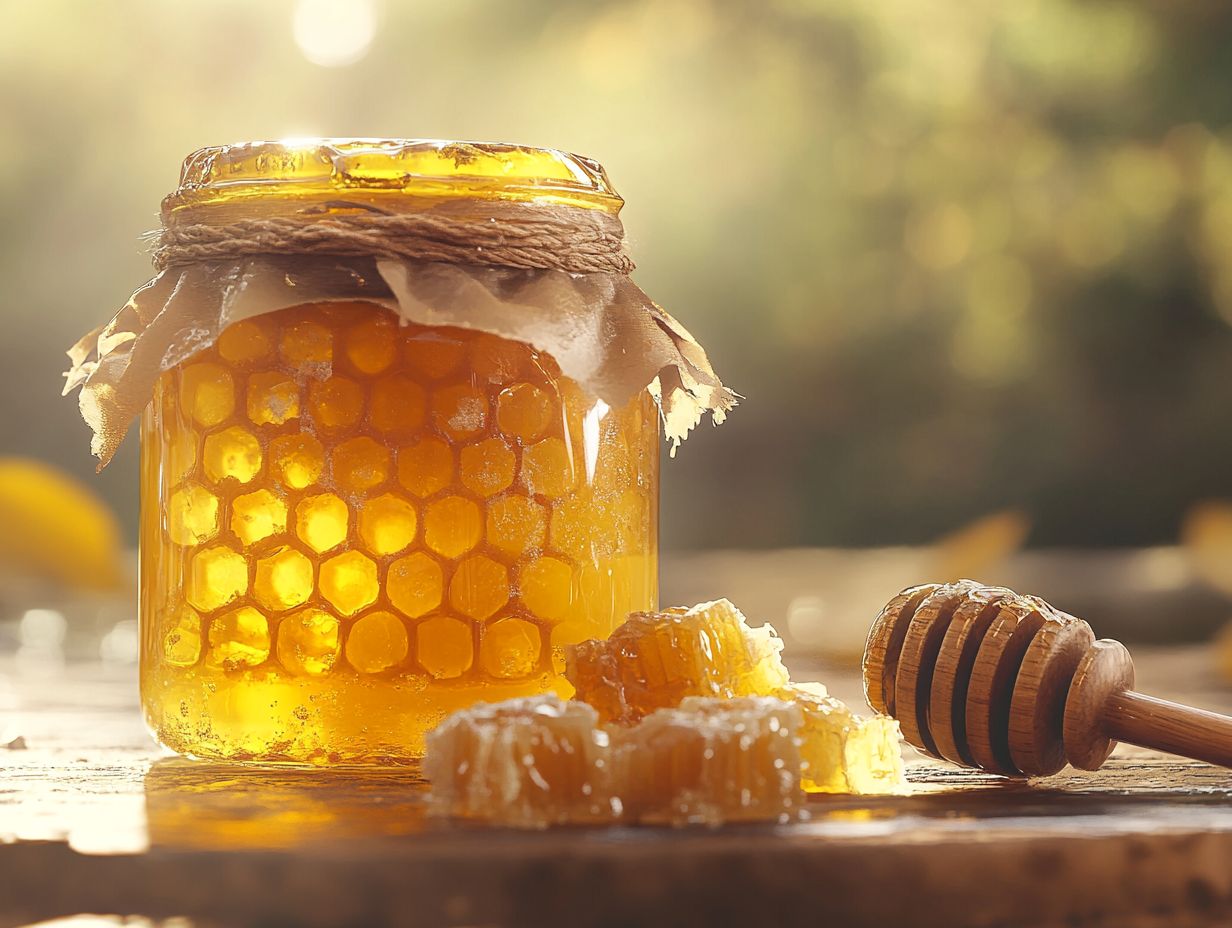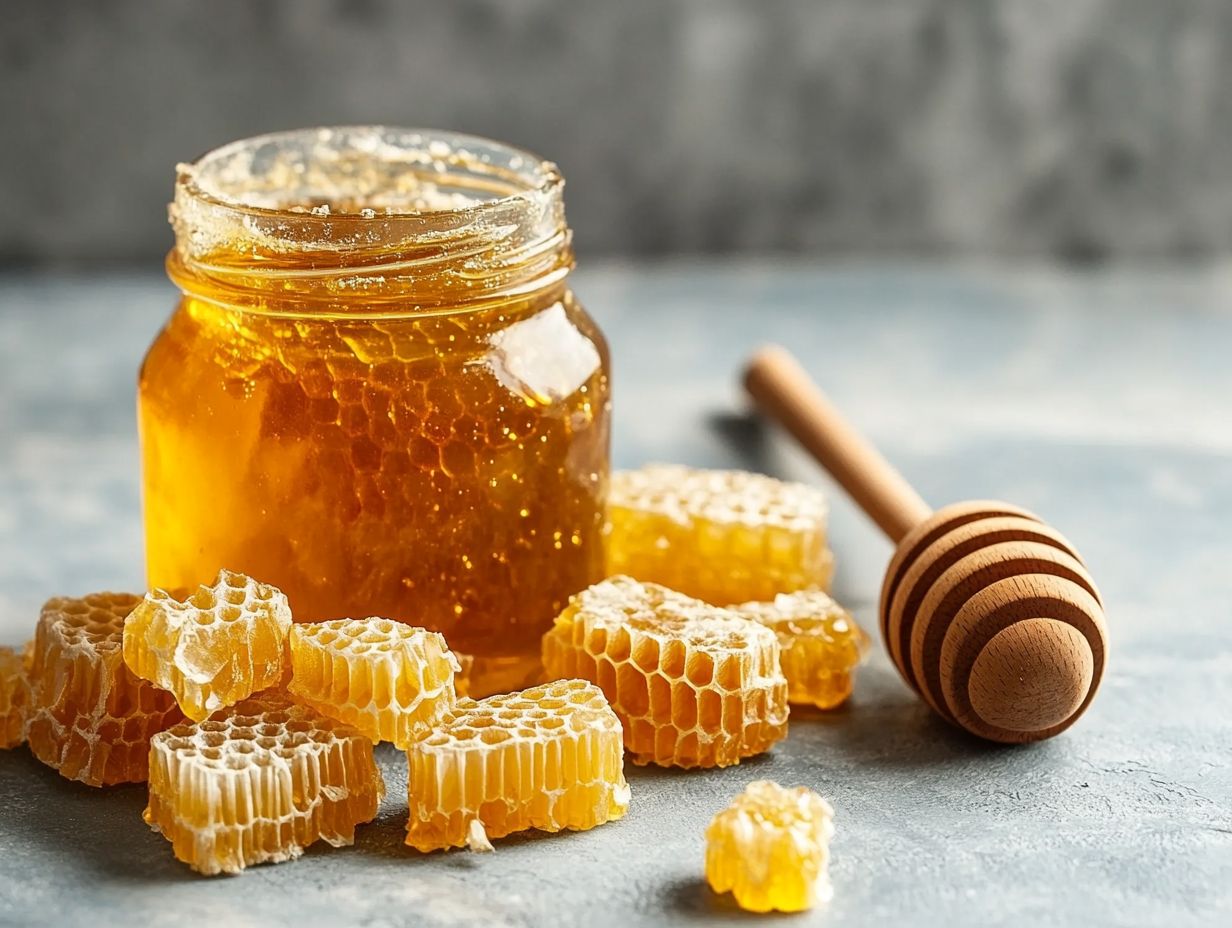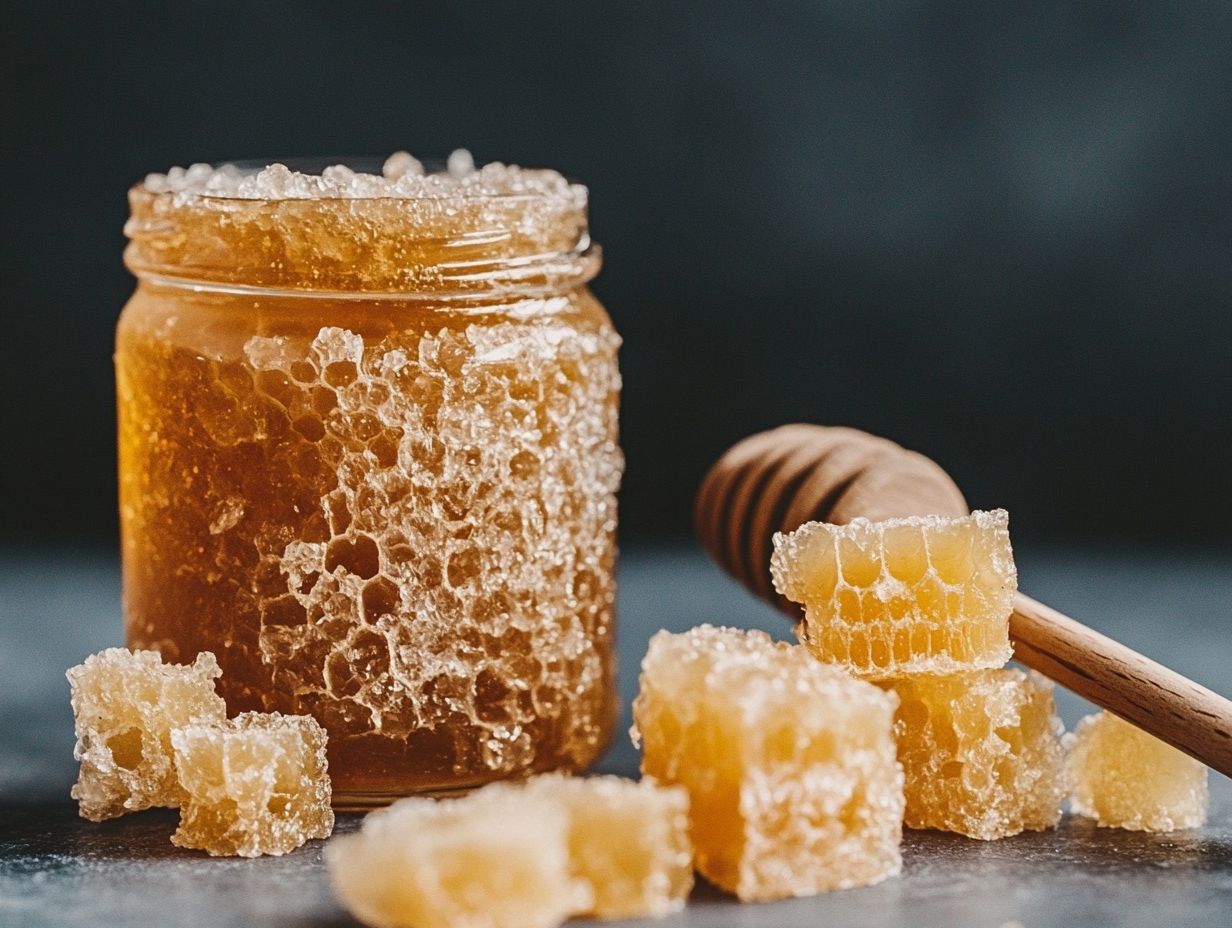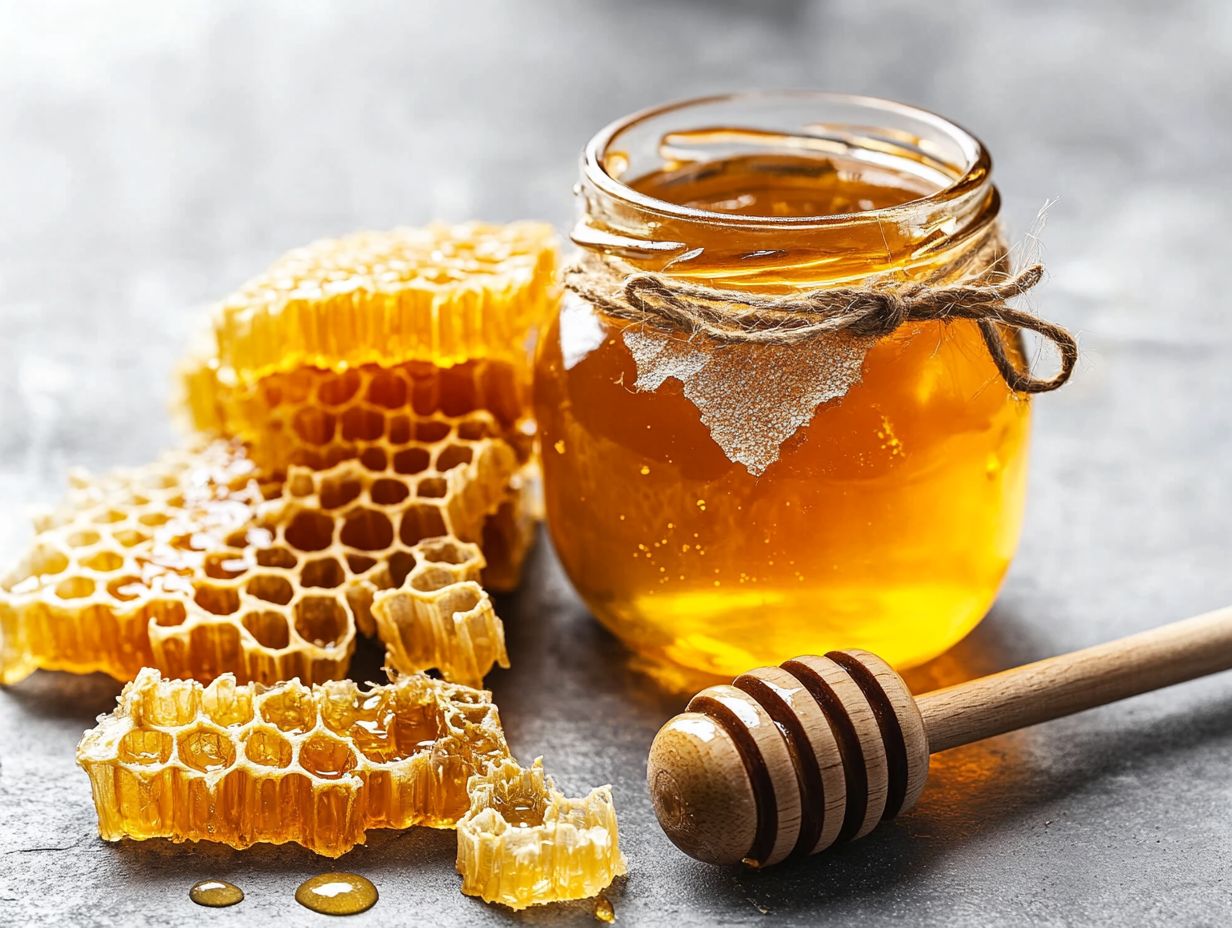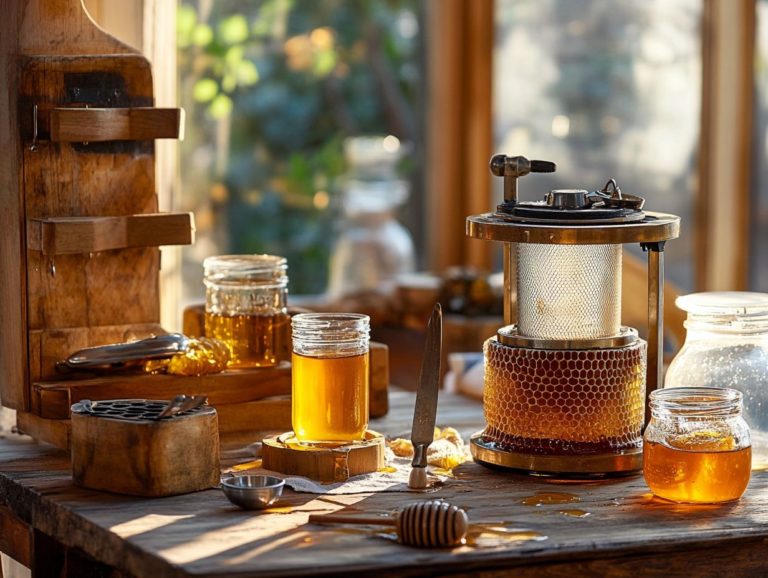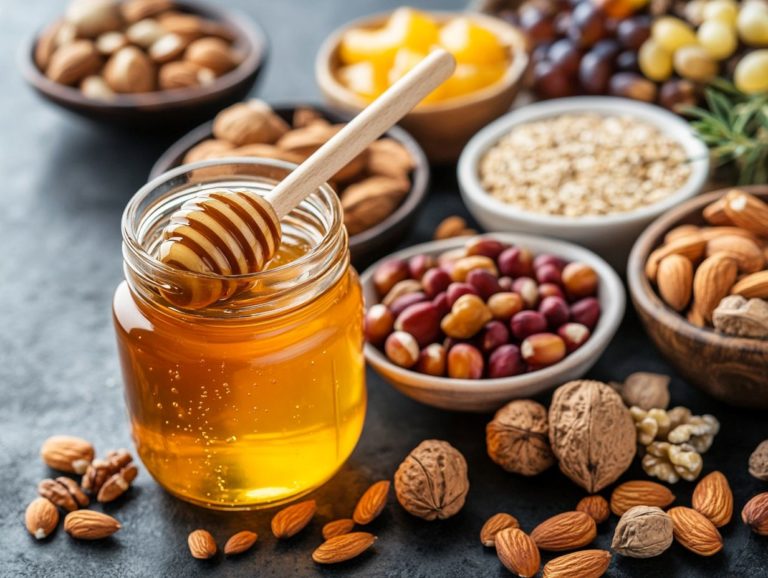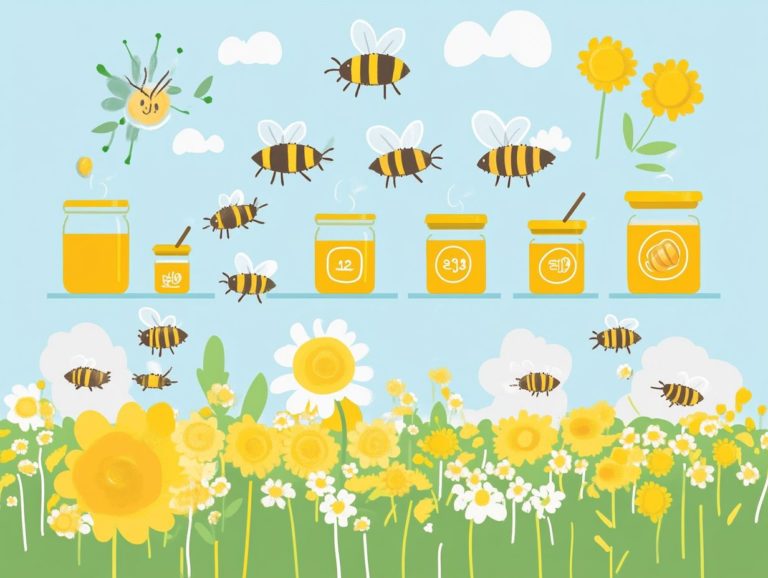The Science Behind Honey Crystallization
Honey, a natural sweetener, is often celebrated for its delightful sweetness and impressive health benefits. But have you ever encountered it in a gritty, solid state?
This intriguing phenomenon, known as honey crystallization, raises several questions about its safety and effects on overall honey benefits.
- What triggers this transformation?
- Is it safe to consume, especially considering the effects of fermentation?
- Are there any advantages to this change in texture and taste, particularly for cooking with honey?
Let’s dive into the fascinating science of honey crystallization! This article explores its causes, benefits, and practical tips for both prevention and reversal—especially for raw honey enthusiasts.
Whether you’re a devoted honey lover or just curious about this sweet subject, including unique varieties like Mike’s Hot Honey and gourmet honey, there’s much to uncover!
Contents
Key Takeaways:
- Honey can crystallize over time due to its sugar content, resulting in a thicker, grainy texture.
- This natural process is caused by the ratio of glucose and fructose in honey, as well as storage temperature and pollen content.
- Crystallized honey is safe to eat and may offer additional health benefits, making it a great option for cooking and baking.
What is Honey Crystallization?
Honey crystallization is a natural process that unfolds when honey, that delightful sweetener crafted by bees, begins to form solid crystals over time. This phenomenon arises from the sugar content—primarily glucose and fructose—present in raw honey, resulting in a unique texture and consistency that many find quite appealing.
Some might mistakenly view crystallized honey as a sign of aging or spoilage. However, it’s a normal part of its preservation journey. This intriguing transformation offers insights into the honey production process and highlights the diverse qualities of different honey types, including gourmet varieties from local gems like Mike’s Hot Honey and the Gowanus Apiary.
What Causes Honey to Crystallize?
The crystallization of honey happens primarily because of its high sugar content, especially glucose. This sugar naturally separates from the honey that has a lot of sugar dissolved in it, leading to the formation of delightful crystalline structures you find in some honey jars.
Several factors influence this process. These include the balance between glucose and fructose concentrations, the moisture content, and the fermentation stage of the honey. When glucose levels are higher compared to fructose, crystallization is more likely to occur, especially in raw versus processed honey comparisons.
Moisture plays a crucial role. Honey with lower moisture content tends to crystallize more quickly, making proper storage essential. If fermentation alters the sugar composition, it can hinder crystallization if not managed properly, emphasizing the importance of good beekeeping practices.
Different honey varieties, such as Manuka, show unique behaviors in response to these factors. Their distinctive sugar profiles and moisture retention characteristics lead to varying textures and rates of crystallization, giving each type its own charm.
Is Crystallized Honey Safe to Eat?
Crystallized honey is typically safe for you to enjoy. It preserves its original flavor and health benefits, making it an excellent natural sweetener for all sorts of culinary delights.
It’s worth noting that crystallization is a perfectly natural process, often occurring when honey is kept for extended periods or stored at cooler temperatures. While the texture may shift, rest assured that its safety and nutritional value remain intact, especially when using airtight containers for preservation.
When comparing crystallized honey to fresh raw honey, both provide similar health benefits. However, the texture can range from smooth to delightfully grainy.
To keep your crystallized honey in prime condition, storing it in airtight containers is essential. Exposure to air can lead to moisture absorption and fermentation, negatively affecting its taste and quality, ultimately reducing its overall health benefits.
Don’t miss out on discovering the secrets behind your favorite sweetener! Try different types of honey and share your experiences with honey crystallization.
How Does Honey Crystallization Happen?
Honey crystallization is a captivating process. It occurs when a solution of sugars, primarily glucose and fructose, reaches a point where crystals start to form. This creates the delightful crystallized texture that many people find appealing.
Factors like fermentation or poor storage can speed up this process. Understanding honey’s traits helps maintain its quality, letting you enjoy it at its best—especially when exploring local varieties like those from the Savannah Bee Company.
What is the Role of Glucose and Fructose in Crystallization?
Glucose plays a key role in the crystallization of honey, as it is the primary sugar responsible for solid crystal formation. Its ability to precipitate from the solution outshines that of fructose, which tends to remain more soluble in honey.
This distinct behavior comes from their unique chemical structures. Glucose, a monosaccharide with a strong tendency to crystallize, can form stable nuclei that attract additional glucose molecules, speeding up the process. In contrast, fructose is more soluble and often impedes crystallization, resulting in a smoother consistency that is desirable in some culinary applications.
Organic acids and other components, such as proteins and minerals, also influence how these sugars interact, either fostering or hindering crystallization. Variations in sugar content, stemming from different floral sources or processing methods, can significantly alter the crystallization rate and lead to diverse textures and flavors in the final product.
How Does Temperature Affect Honey Crystallization?
Temperature greatly influences crystallization. Cooler temperatures slow the process, while warmer conditions can speed it up.
To maintain an ideal environment for your honey and prolong its liquid state, aim to store it at a consistent room temperature—around 70°F is optimal. This helps preserve the honey’s texture and prevents premature crystallization.
Conversely, temperatures below 50°F can speed up crystallization, resulting in an unappealing grainy consistency. To protect against these changes, use airtight containers and store your honey in a cool, dark cupboard away from direct sunlight. This strategy keeps your honey smooth while preserving its rich taste and nutritional benefits.
What is the Role of Pollen and Pollen Grains in Crystallization?
Pollen grains are crucial for crystallization. They provide surfaces for honey particles to gather, helping form crystals. This interaction not only contributes to the distinct crystallized texture of honey but also intrigues those who appreciate its nuances, including the health benefits associated with pollen.
This dynamic influences the physical attributes of honey and enriches its nutritional profile. Pollen is packed with vitamins, minerals, and proteins, offering health benefits like enhancing immunity and promoting overall wellness.
Various bee species collect different types of pollen, impacting the properties, flavor, and color of honey. For instance, honey from clover pollen is typically lighter and milder, while honey sourced from wildflowers offers a more robust flavor profile. This creates a delightful spectrum of taste experiences!
The synergy between pollen and honey amplifies the product’s complexity, transforming each jar into a unique reflection of its environmental origins.
Explore local honey varieties to discover the rich flavors and textures they offer. Enjoy your honey adventure!
What are the Benefits of Honey Crystallization?
Honey crystallization offers an array of benefits that enhance its nutritional properties. It also introduces a delightful texture that many find irresistible for cooking.
Imagine spreading it effortlessly on crumpets or elevating your baked goods with its unique charm—a real treat!
Does Crystallized Honey Have More Nutritional Benefits?
Crystallized honey retains essential nutrients found in raw honey, including antioxidants and organic acids. These contribute to its health benefits, making it a nutritious choice regardless of texture.
Some consumers may view this transformation skeptically. However, it does not lessen the rich array of vitamins, minerals, and enzymes that support overall well-being. In fact, many health enthusiasts argue that crystallized honey offers advantages, like a thicker consistency that enhances its spreadability on toast or pastries.
You might also find it easier to digest than the liquid version, all while maintaining those same health-boosting properties. With both forms offering similar nutritional value, the decision ultimately comes down to personal preference.
Is Crystallized Honey Easier to Use for Cooking and Baking?
Crystallized honey can be a game changer in your cooking and baking. Its thick texture makes flavors pop, offering a unique experience that liquid honey can’t match.
This delightful form of honey isn’t just practical; it opens up exciting cooking ideas. Imagine slathering it on toast or drizzling it over pancakes, instantly turning your breakfast into a gourmet affair.
You can also use crystallized honey in salad dressings, where its subtle sweetness balances tangy vinaigrettes beautifully.
Explore gourmet varieties like wildflower or lavender-infused crystallized honey to elevate your desserts—think cookies and cakes with memorable textures and flavors. It can also serve as a natural sweetener in marinades or glazes, pairing wonderfully with meats or roasted vegetables for extra depth.
How to Prevent Honey from Crystallizing?
To prevent honey from crystallizing, use several simple ways. Start by storing it at the right temperatures. Keeping it in a cool, stable environment is key.
Using airtight containers helps keep moisture out, preserving honey’s delightful liquid state for you to enjoy.
What is the Best Way to Store Honey to Prevent Crystallization?
To prevent honey from crystallizing, store it in a cool, dark place in an airtight container. Light and air can activate the crystallization process, so keeping it sealed is essential.
Aim for a temperature between 50-70°F (10-21°C) to maintain its natural viscosity and flavor. Glass jars are preferable to plastic ones; they are non-reactive and help maintain ideal conditions for your honey.
Proper storage is vital not only to avoid crystallization but also to protect the unique taste and texture that make honey special. When stored correctly, its aromatic qualities and rich flavors can last for years, ensuring that every delightful drizzle remains as fresh as the day it was harvested.
Are There Any Additives that Can Prevent Honey Crystallization?
While there aren’t any widely accepted additives to prevent honey from crystallizing, you can adopt certain practices to keep it liquid without sacrificing safety or quality.
For example, storing your honey in a warm, dry environment can significantly reduce the likelihood of crystallization. Some manufacturers even recommend using fine-filtering techniques to remove pollen and other particulates that may speed up the crystallization process.
It’s essential to remember that different honey varieties have unique tendencies; some are more prone to crystallization due to their sugar compositions. By following these tips, both beekeepers and consumers can enjoy a sweeter, more fluid honey experience while preserving its natural flavor and safety.
Can You Reverse Honey Crystallization?
You can indeed reverse honey crystallization by gently warming the crystallized honey. Typically, using a warm water bath is the most effective method. This helps dissolve the sugar crystals and returns the honey to its liquid state while preserving its quality.
What Methods Can Be Used to Turn Back Crystallized Honey into Liquid?
To turn crystallized honey back into liquid, you can use common methods like gently heating it in a saucepan or placing the jar in a warm water bath. It’s essential to keep the temperature below 110°F. This preserves honey’s natural properties, which refer to the beneficial compounds found in honey.
The right temperature is vital. Too much heat can harm the delicate enzymes and antioxidants that give honey its impressive nutritional benefits. By maintaining a steady warmth, you’ll restore the honey’s consistency without compromising its flavor or health benefits.
Avoid using the microwave; it can create hot spots that ruin honey’s flavor.
Is Re-heating Honey Safe?
Reheating honey is perfectly safe, as long as you do it carefully. Aim to keep the temperature below 104°F (40°C) to preserve honey’s beneficial properties. Exceeding this limit can break down important antioxidants and vitamins, undermining many of its health advantages.
If you want to warm honey for cooking or to mix it into beverages, gentle methods work best. Consider placing the jar in warm water. This will help you achieve the desired consistency without sacrificing honey’s integrity.
By following these easy steps, you can enjoy honey’s delightful flavors and incredible health benefits without delay!
Frequently Asked Questions
Got questions about honey? We’ve got all the answers you need right here!
What is the science behind honey crystallization?
Honey crystallization is when glucose separates from water, forming sugar crystals. This happens due to the high sugar content and low water content in honey.
Why does honey crystallize?
Honey crystallizes because it is a supersaturated solution. This means it contains more sugar than it can hold in liquid form, causing the excess sugar to separate and form crystals.
Does all honey crystallize?
Yes, all honey will eventually crystallize. The rate of crystallization depends on factors such as the type of honey, temperature, and storage conditions.
Is crystallized honey still safe to eat?
Yes, crystallized honey is perfectly safe to eat. Many people prefer its texture and spreadability. It remains rich in nutrients and has the same health benefits as liquid honey.
How can I prevent honey from crystallizing?
To prevent honey from crystallizing, store it in a cool, dry place. Avoid exposing it to direct sunlight or high temperatures. You can also heat the honey in a warm water bath to dissolve the crystals and return it to liquid form.
Can I reverse honey crystallization?
Yes, you can reverse honey crystallization by gently heating the honey in a warm water bath until the crystals dissolve. Be careful not to overheat the honey, as it may affect its flavor and nutrient content.

